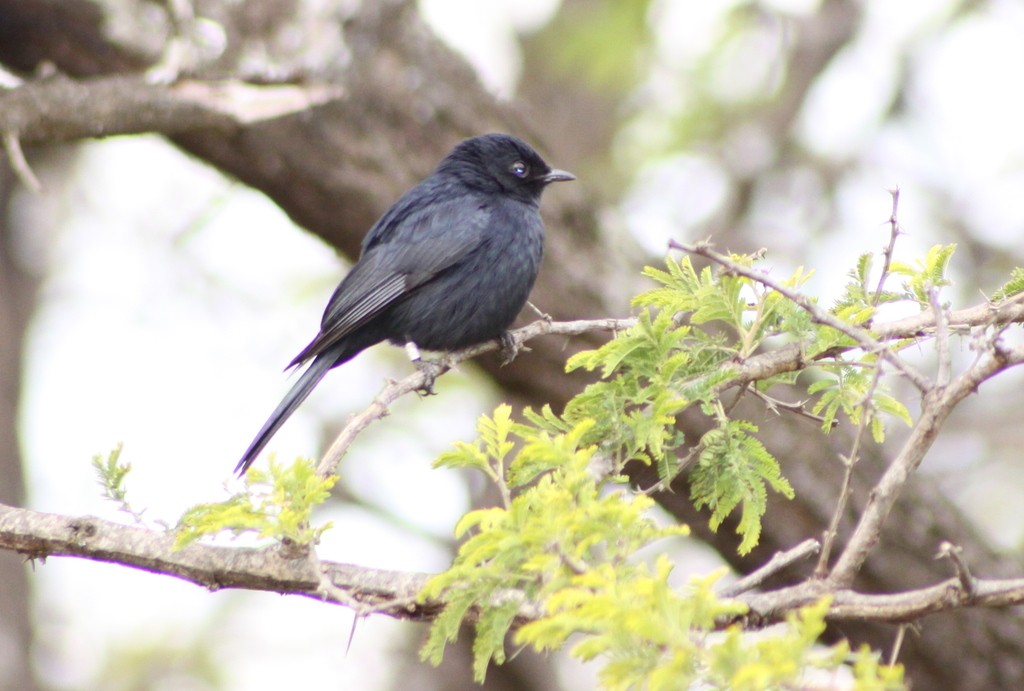Southern Black Flycatcher
A species of Melaenornis Scientific name : Melaenornis pammelaina Genus : Melaenornis
Southern Black Flycatcher, A species of Melaenornis
Botanical name: Melaenornis pammelaina
Genus: Melaenornis
Content
Description General Info
Description
The southern black flycatcher is entirely black, with a black beak and black legs. The iris of the eye is brown and this, along with the square-cut tail, helps distinguish it from the otherwise similar fork-tailed drongo (Dicrurus adsimilis) which has a red iris and long forked tail. 
Size
22 cm
Nest Placement
Tree
Feeding Habits
Southern Black Flycatcher's diet consists primarily of insects, including ants, termites, and beetles, as well as spiders, centipedes, and worms. It may consume nectar or insects from aloe flowers and small fruits. Southern Black Flycatcher forages alone or in groups, using perching tactics to scan and capture prey with sudden drops or short sallies. It often feeds in association with the Fork-tailed Drongo, mimicking its behavior.
Habitat
Southern Black Flycatcher's habitat includes open woodlands such as miombo, Baikiaea, and tall acacia, as well as mopane and mixed broadleaf forests. It also inhabits bushlands, thornveld, and coastal dune forests. Preferring areas under the woodland canopy with clear ground views, southern Black Flycatcher can be found in forest clearings, parks, gardens, and plantations. This species is attracted to freshly burnt areas and adapts well to cultivated lands with scattered trees, thriving across broad geographical regions that encompass eastern and southern Africa.
Dite type
Insectivorous
General Info
Feeding Habits
Bird food type
Behavior
The southern black flycatcher is a mainly insectivorous bird. Its diet includes beetles, termites, locusts, worms, spiders and centipedes. Its main foraging technique is to perch on a low eminence such as a branch or fence post and pounce on prey in the air or on the ground below. It is also known to sip nectar from the flowers of mountain aloe (Aloe marlothii) and to eat the berries of the black nightshade (Solanum nigrum). It sometimes forages in small flocks, often associating with fork-tailed drongos. Breeding takes place between May and January, peaking in September and October. The nest is usually built in a recess in a tree trunk or behind a loose slab of bark, but is sometimes in a tangle of creepers, the sheath of a palm frond, banana bunch or an abandoned farm implement. It is cup-shaped and composed of twigs and dry grasses, lined with fine rootlets. Up to four eggs are laid and incubation lasts about two weeks with the young fledging and leaving the nest in fifteen to twenty days. 
Distribution Area
The southern black flycatcher is native to eastern and southern Africa. It has been recorded from Somalia, Kenya, Tanzania, Rwanda, Burundi, Congo, the Democratic Republic of the Congo, Angola, Namibia, Swaziland, Botswana, Malawi, Mozambique, Zambia, Zimbabwe, Lesotho and South Africa. It is typically found in habitats with open areas and light woodland, riparian corridors, the edges of plantations and in gardens. The trees in these habitats include miombo (Brachystegia spp.), thorntrees (Acacia spp.) and mopane (Colosphermum mopane). 
Species Status
Not globally threatened.
Scientific Classification
Phylum
Chordates Class
Birds Order
Perching birds Family
Old world flycatchers Genus
Melaenornis Species
Southern Black Flycatcher 